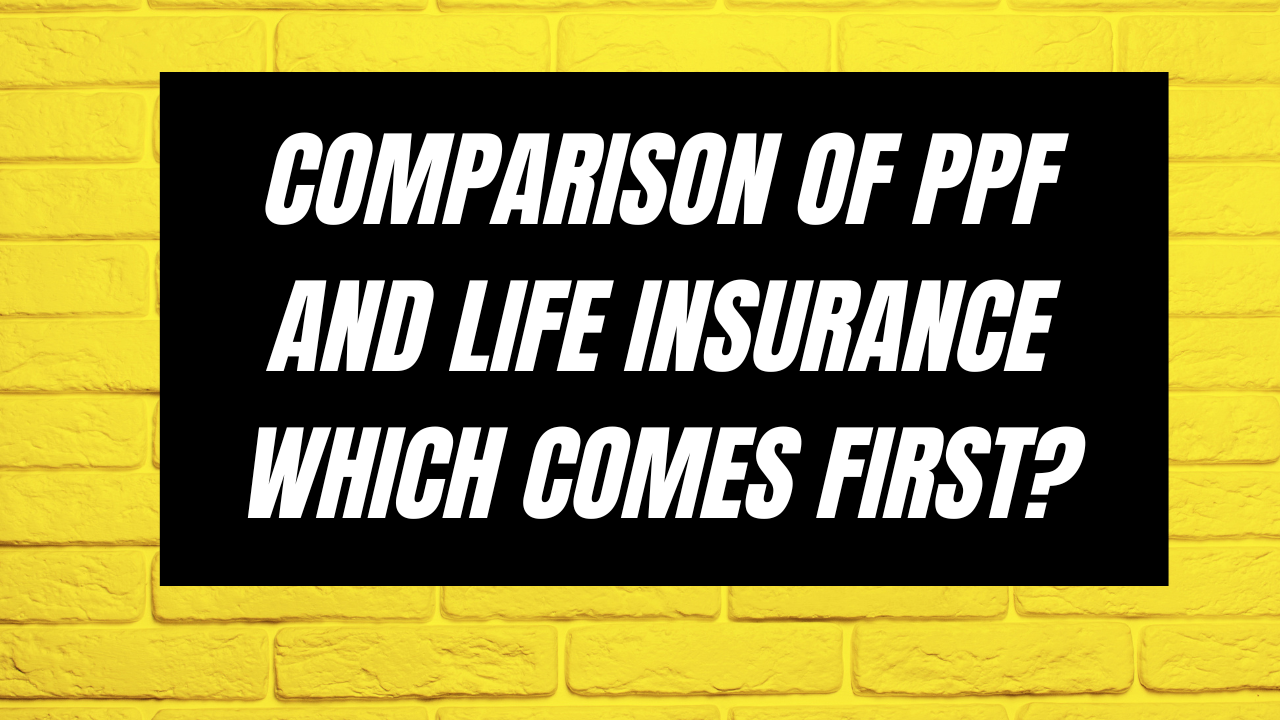Introduction to PPF and Life Insurance:
PPF (Public Provident Fund):
PPF is a popular long-term savings and investment scheme offered by the Indian government. It is a safe and tax-efficient investment option that encourages individuals to save for their retirement and other long-term financial goals. PPF accounts have a maturity period of 15 years and offer attractive interest rates, making them a preferred choice for conservative investors.
Life Insurance:
Life insurance is a financial product that provides financial protection to the policyholder’s beneficiaries in the event of the policyholder’s death. It serves as a safety net for the family’s financial security, offering a lump sum or periodic payouts (death benefit) to the beneficiaries. Life insurance policies come in various forms, such as term insurance, whole life insurance, endowment plans, and unit-linked insurance plans (ULIPs), catering to different financial needs and goals.
Tax Benefits and Deductions:
PPF (Public Provident Fund) Tax Benefits:
- Tax-Free Interest: The interest earned on PPF deposits is entirely tax-free, making it an attractive option for tax-efficient savings.
- Tax Deduction: Contributions made to the PPF account are eligible for a tax deduction under Section 80C of the Income Tax Act, up to a maximum of Rs. 1.5 lakh per financial year.
- Tax-Free Withdrawals: The entire maturity amount, including the interest, is tax-free upon the completion of the 15-year tenure.
- No Wealth Tax: The PPF account balance is exempt from wealth tax, further enhancing its appeal as a tax-saving investment.
Life Insurance Tax Benefits:
- Tax Deduction on Premiums: Premiums paid towards life insurance policies, including term insurance and endowment plans, qualify for a tax deduction under Section 80C of the Income Tax Act, subject to a maximum of Rs. 1.5 lakh per financial year.
- Tax-Free Death Benefit: The death benefit received by the policyholder’s beneficiaries is tax-free under Section 10(10D) of the Income Tax Act. The entire payout goes to the beneficiaries without any tax liability.
- Tax Savings for ULIPs: Unit-linked insurance plans (ULIPs) offer dual benefits of life insurance and investment. Premiums paid towards ULIPs are eligible for tax deductions under Section 80C, and the maturity amount and death benefit are tax-free under Section 10(10D).
- Additional Tax Deduction for Health Riders: Premiums paid for riders like critical illness or health insurance attached to life insurance policies may be eligible for an additional tax deduction under Section 80D.
Investment Returns and Risk:
PPF (Public Provident Fund) Investment Returns and Risk:
- Investment Returns: PPF offers attractive and stable returns, which are determined by the government and revised periodically. As of the current date, the PPF interest rate is set by the government and is subject to change every quarter. PPF returns are generally considered safe and predictable.
- Risk Profile: PPF is considered a low-risk investment option since it is backed by the Indian government. The principal amount and interest earned are guaranteed by the government, providing investors with a sense of security.
Life Insurance Investment Returns and Risk:
- Investment Returns: Life insurance policies with investment components, such as endowment plans and unit-linked insurance plans (ULIPs), offer returns based on the underlying investments. ULIP returns depend on the performance of the chosen funds, which may include equity, debt, or a combination of both. Endowment plans typically offer guaranteed returns along with bonuses or participation in profits.
- Risk Profile: The risk associated with life insurance policies varies based on the type of policy chosen. Traditional endowment plans offer moderate risk since they provide guaranteed returns, while ULIPs carry higher risk due to exposure to market fluctuations. Term insurance, which only provides life coverage, does not involve any investment risk.
Tenure and Maturity:
PPF (Public Provident Fund) Tenure and Maturity:
- Tenure: The maturity period of a PPF account is 15 years from the date of opening. After the initial 15 years, the account can be extended in blocks of 5 years.
- Maturity: On completion of the 15-year period, the PPF account matures, and the account holder becomes eligible to withdraw the entire accumulated amount, including the principal and interest. The maturity amount is tax-free.
Life Insurance Tenure and Maturity:
- Tenure: The tenure of a life insurance policy varies based on the type of policy chosen. Term insurance policies offer coverage for a specific term, typically ranging from 5 to 30 years. Endowment plans and whole life policies have specific maturity periods mentioned in the policy contract.
- Maturity: For endowment plans, the policyholder receives the maturity benefit at the end of the policy term, which may include the sum assured along with bonuses or profits. Term insurance policies do not have a maturity benefit since they only provide coverage for a specific period.
Insurance Coverage and Protection:
PPF (Public Provident Fund) Insurance Coverage and Protection:
- Insurance Coverage: PPF does not provide any insurance coverage. It is primarily a savings and investment tool offered by the government to promote long-term savings and retirement planning.
- Protection Benefits: PPF focuses solely on accumulating funds and does not offer any life insurance or health coverage. In the event of the account holder’s demise, the accumulated amount is passed on to the nominee or legal heir as per the PPF rules.
Life Insurance Coverage and Protection:
- Insurance Coverage: Life insurance policies provide financial protection to the policyholder’s beneficiaries in case of the insured’s death during the policy term. The death benefit is paid out to the nominee, ensuring financial security and support to the insured’s family members.
- Protection Benefits: Life insurance offers a death benefit that can be used to cover various expenses such as outstanding debts, living expenses, education costs, or other financial obligations. This benefit provides peace of mind and ensures the insured’s loved ones are financially protected in their absence.
Loan Facility and Withdrawal Flexibility:
PPF (Public Provident Fund) Loan Facility and Withdrawal Flexibility:
- Loan Facility: PPF accounts offer a loan facility to account holders from the 3rd to the 6th financial year, starting from the year of account opening. The loan amount is limited to a maximum of 25% of the account balance at the end of the second financial year preceding the year in which the loan is applied for.
- Withdrawal Flexibility: Partial withdrawals are allowed from the 7th financial year onwards. Account holders can make partial withdrawals from the PPF account, subject to certain conditions and limits prescribed by the government.
Life Insurance Loan Facility and Withdrawal Flexibility:
- Loan Facility: Traditional life insurance policies like endowment plans may offer loan facilities to policyholders. The loan amount is usually a percentage of the policy’s surrender value, and interest is charged on the loan amount.
- Withdrawal Flexibility: Some life insurance policies like unit-linked insurance plans (ULIPs) allow partial withdrawals after a specified lock-in period. Policyholders can withdraw a portion of the fund value to meet financial needs, subject to the terms and conditions of the policy.
Eligibility and Accessibility:
PPF (Public Provident Fund) Eligibility and Accessibility:
- Eligibility: Any resident individual, including minors, can open a PPF account. Non-resident individuals and Hindu Undivided Families (HUFs) are not eligible to open a PPF account.
- Accessibility: PPF accounts can be opened at designated banks, post offices, and some authorized financial institutions. The account holder can access and manage the account through these authorized branches.
Life Insurance Eligibility and Accessibility:
- Eligibility: Individuals meeting the eligibility criteria set by the insurance company can apply for life insurance policies. The eligibility factors include age, health condition, and insurability based on the underwriting guidelines of the insurance provider.
- Accessibility: Life insurance policies are available through various insurance companies and their agents. Policy applications can be submitted online or through physical channels, making them accessible to individuals across the country.
FAQs about PPF and Life Insurance:
- Can I open both a PPF account and a life insurance policy?
- Yes, you can have both a PPF account and a life insurance policy simultaneously. Each serves different financial objectives, and having both can complement your financial planning.
- Is there a maximum limit on the amount I can invest in PPF and claim tax benefits?
- Yes, the maximum amount eligible for tax deduction under Section 80C is Rs. 1.5 lakh per financial year, which includes contributions to PPF and other eligible investments.
- Are the returns from life insurance policies guaranteed?
- The returns from life insurance policies depend on the type of policy chosen. Traditional policies like endowment plans offer guaranteed returns, while returns from unit-linked insurance plans (ULIPs) are market-linked and subject to market performance.
Conclusion:
Both PPF and life insurance are valuable financial tools that cater to different aspects of an individual’s financial planning. PPF offers a safe and tax-efficient savings and investment option with guaranteed returns and long-term benefits. On the other hand, life insurance provides financial protection to the insured’s family and offers a death benefit in case of the insured’s demise.
Read More:
- Post Office Savings Account: Benefits and How to Open an Account
- 7 Simple Ways to Start Saving for a Bright Future
- How can I grow my savings fast?
- Saving Account: Types, Interest rates, and eligibility criteria




